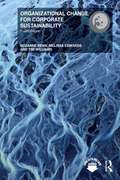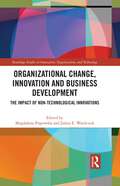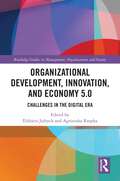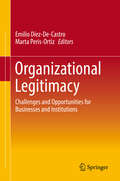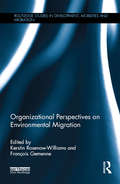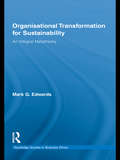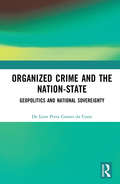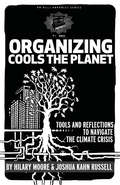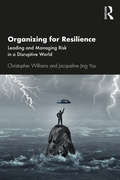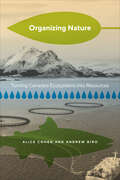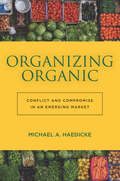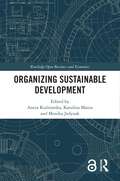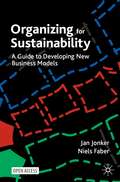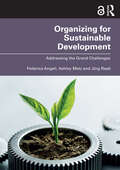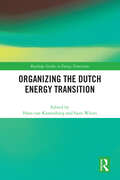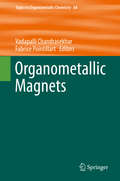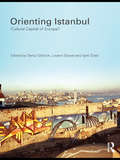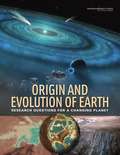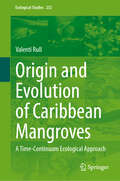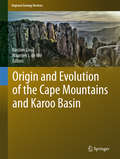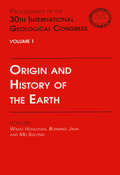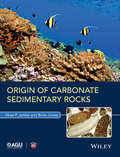- Table View
- List View
Organizational Change for Corporate Sustainability: A Guide For Leaders And Change Agents Of The Future (Understanding Organizational Change Ser.)
by Tim Williams Suzanne Benn Melissa EdwardsSince this classic book was first published in 2003, sustainability has increasingly been accepted as standard business practice for leading corporations, while the science itself has revealed how human activity has become the dominant force influencing irreversible changes in the planetary systems. The fourth edition of this trailblazing book on corporate sustainability provides new insights into how organizations can transition towards a more responsible way of conducting their business. It charts new thinking on value creation, business models and organizational purpose as the basis of a broader-based transition to a sustainable society. The sustainability phase model has been substantially revised to incorporate emergent approaches in sustainable supply chain management, strategic sustainability, sustainability-oriented innovation and new business models. There is a companion website that contains a range of materials to support learning. This new edition with the authors’ unified approach to sustainable business reshapes its plan of action to bring about corporate change by drawing in new management theory and practice on strategy-making and leadership, making it core reading for students and researchers of sustainability and business, organizational change and corporate social responsibility.
Organizational Change, Innovation and Business Development: The Impact of Non-Technological Innovations (Routledge Studies in Innovation, Organizations and Technology)
by Magdalena Popowska Julita E WasilczukThis volume presents a collection of different views and perspectives, featuring both theoretical and empirical contributions, to provide deep insight into the role of innovation and of non-technological innovation (NTI) in contemporary business. It illustrates how NTI encourages organizational development as well as competitive advantage. Chapters display a variety of research methods, both qualitative and quantitative, including case studies, best practices, surveys, novel approaches to interpretations, concepts and theories. Together they contribute to a significant extension of the existing knowledge on non-technological innovations and their role in organizations. This volume highlights the effects of marketing and organizational innovation strategies on companies’ innovation and overall performance, while demonstrating that the effects of NTI may vary depending on the phase of the innovation process, and how it differs within small, medium and large enterprises from manufacturing and service industries. It explores the bidirectional relationship between technological innovation (TI) and NTI, and considers the competences needed to implement NTI. The book is written for scholars and academic professionals from a wide variety of disciplines addressing issues of organizational change and innovation, new management techniques and strategies, and the sustainable growth of organizations. It may also be an interesting source of knowledge for graduate and postgraduate students in management.
Organizational Change, Innovation and Business Development: The Impact of Non-Technological Innovations (Routledge Studies in Innovation, Organizations and Technology)
by Magdalena Popowska Julita E WasilczukThis volume presents a collection of different views and perspectives, featuring both theoretical and empirical contributions, to provide deep insight into the role of innovation and of non-technological innovation (NTI) in contemporary business. It illustrates how NTI encourages organizational development as well as competitive advantage.Chapters display a variety of research methods, both qualitative and quantitative, including case studies, best practices, surveys, novel approaches to interpretations, concepts and theories. Together they contribute to a significant extension of the existing knowledge on non-technological innovations and their role in organizations. This volume highlights the effects of marketing and organizational innovation strategies on companies’ innovation and overall performance, while demonstrating that the effects of NTI may vary depending on the phase of the innovation process, and how it differs within small, medium and large enterprises from manufacturing and service industries. It explores the bidirectional relationship between technological innovation (TI) and NTI, and considers the competences needed to implement NTI.The book is written for scholars and academic professionals from a wide variety of disciplines addressing issues of organizational change and innovation, new management techniques and strategies, and the sustainable growth of organizations. It may also be an interesting source of knowledge for graduate and postgraduate students in management.
Organizational Development, Innovation, and Economy 5.0: Challenges in the Digital Era (Routledge Studies in Management, Organizations and Society)
by Agnieszka Rzepka Elżbieta JędrychThis edited collection comprehensively explores Economy 5.0, focusing on critical aspects such as organizational development, intellectual capital, soft agent dynamics, and agility. Through in-depth analysis, real-world case studies, and forward-looking perspectives, the book provides readers with practical insights into the challenges and opportunities that define contemporary organizations and skills that can be applied in different cultural and organizational contexts. The overarching goal is to empower individuals to thrive in the dynamic economic landscape of Economy 5.0 by promoting sustainable practices, fostering future-proof skill sets, encouraging ethical leadership, and inspiring innovative solutions. It addresses issues and trends that are universally relevant in today's globalized world, offering a multidisciplinary perspective that will make it valuable to researchers, academics, practitioners, and students in the fields of organizational development, management, innovation, sustainability, and ethical leadership.
Organizational Legitimacy: Challenges And Opportunities For Businesses And Institutions
by Marta Peris-Ortiz Emilio Díez-De-CastroThis volume explores organizational legitimacy in business, featuring examples from a variety of industries around the world. Synthesizing the most current theoretical insights and best practices, the contributing authors examine the ways in which organizational legitimacy can be understood, its perceived influence on the market, and the relationship between organizational legitimacy and overall organizational success. The authors draw from different methodological perspectives to develop a holistic approach to organizational legitimacy that transcends the traditional concepts of corporate reputation, business ethics or corporate social responsibility. Historically, efforts to understand how organizations acquire, manage and use legitimacy have applied insights from institutional theory, resource dependence theory, organizational ecology and stakeholder theory, but the field has remained fragmented, despite the profound implications of achieving legitimacy for ensuring organizational stability, survival and sustainability through access to capital, resources and business opportunities, as well as problem solving, performance measurement and stakeholder support. Presenting case studies of successful initiatives, the book addresses: · How organizational legitimacy is defined and measured · How organizations achieve legitimacy and how they acquire resources · How different stakeholders (e.g., consumers, investors, employees) make legitimacy judgments and resource allocation decisions · Whether audiences in the same socio-cultural context arrive at shared legitimacy judgments with regard to a focal organization
Organizational Perspectives on Environmental Migration (Routledge Studies in Development, Mobilities and Migration)
by Kerstin Rosenow-Williams François GemenneOver the past decade, international organizations (IOs) and non-governmental organizations (NGOs) have increasingly focused their efforts on the plight of environmental migrants in both industrialized and developing countries. However, to date very few studies have analysed the influence and rhetoric of advocacy groups in the debates on environmental migration. Organizational Perspectives on Environmental Migration fills this lacuna by drawing together and examining the related themes of climate change and environmental degradation, migration and organizational studies to provide a fresh perspective on their increasing relevance. In order to assess the role of IOs and NGOs in the environmental migration discourse and to understand their interaction and their ways of addressing the topic, the book contains a wide-range of contributions covering the perspectives of organizational sociologists, political scientists, anthropologists, geographers, lawyers and practitioners. The chapters are organized thematically around the perspectives of key actors in the area of environmental migration, including IOs, courts and advocacy groups. The geographically diverse and interdisciplinary range of contributions makes this volume an essential foundational text for organizational responses to environmental migration. This volume will be of great interest to students and scholars of migration studies, international relations, organizational sociology, refugee law and policy, and development studies.
Organizational Transformation for Sustainability: An Integral Metatheory (Routledge Studies in Business Ethics)
by Mark EdwardsDuring the 21st century organizations will undergo a level of radical and global change that has rarely been seen before. This transformation will come as a result of the environmental, social and economic challenges that now confront organisations in all their activities. But are our understandings and theories of change up to the task of meeting these challenges? Will we be able to develop sustaining visions of how organizations might contribute to the long-term viability of our interdependent global communities? Organizational Transformation for Sustainability: An Integral Metatheory offers some innovative answers to the big questions involved in organizational sustainability and the radical changes that organizations will need to undergo as we move into the third millennium. This new approach comes from the emerging field of integral metatheory. Edwards shows how a "Big Picture" view of organisational transformation can contribute to our understanding of, and search for, organisational sustainability. There are four key themes to the book: i) the need for integrative metatheories for organisational change; ii) the development of a general research method for building metatheory; iii) the description of an integral metatheory for organisational sustainability; and iv) the discussion of the implications of this metatheory for organisational change and social policy regarding sustainability. This book brings a unique and important orienting perspective to these issues.
Organizations and the Natural Environment: Innovations in Sustainability
by Alfred A. MarcusTo what extent can competition between companies encourage innovations in sustainability that have the potential to solve some of the world's major challenges? Using a series of case studies, this book pits closely related competitors against each other to examine the progress in and obstacles to the evolution of sustainable innovations in energy efficiency, solar power, electric vehicles and hybrids, wind energy, healthy eating, and agricultural productivity. It delves into the efforts of Tesla Motors to bring about a revolution in personal transportation, and the challenges Toyota and General Motors (GM) confront in commercializing hybrids. It explores the movement to healthy food by cereal companies General Mills and Kellogg's, and depicts the battles between Whole Foods and Walmart for the world's palate. By examining the experiences that particular businesses have had with sustainable innovation, this insightful book reflects upon lessons learned and encourages readers to think carefully about the challenges that lie ahead.
Organized Crime and the Nation-State: Geopolitics and National Sovereignty
by De Leon Petta Gomes da CostaGeopolitics is an increasingly important tool to understand national and international relations. This book unravels how organized crime is not just a marginal problem but part of a bigger geopolitical and asymmetrical warfare strategy. It seeks to establish a direct relationship between Nation States and organized crime groups. Many States have been using criminal and terrorist organizations as a policy for issues of national sovereignty or as a tool to strengthen a nation’s geopolitical position. This book demonstrates how national states are utilizing criminal organizations in covert operations and "dirty jobs" such as espionage, proxy war, arms trafficking and sabotage. Examples from the United States, China and the Soviet Union are explored, providing both an historical and contemporary analysis, from World War II through to the Cold War and to the present day. The book brings together perspectives from international relations and criminology drawing on insights from a variety of sources, including public documents and interviews.
Organizing Cools the Planet: Tools and Reflections on Navigating the Climate Crisis (PM Pamphlet)
by Hilary Moore Joshua Kahn RussellOrganizing Cools The Planet weaves together stories, analysis, organizing tools, and provocative questions, to offer a snapshot of U.S. climate activism and provide pathways for readers to participate in it. Authors share hard lessons learned, reflect on strategy, and grapple with the challenges of their roles as organizers who do not come from "frontline" communities, but work to amplify and build a climate justice movement led by low-income people, communities of color, Indigenous, youth and other constituencies most directly impacted by the crisis. Rooted in the authors' experiences organizing in local, national, and international arenas, this pamphlet grapples with the challenges and overwhelming odds young activists face today. Organizing Cools the Planet challenges readers to look at the scale of ecological collapse with open eyes, without falling prey to disempowering doomsday narratives. It asks key pressing questions for those who wish to take our generational challenge seriously. This pamphlet is for anyone who wants to build a movement with the resiliency to navigate one of the most rapid transitions in human history.
Organizing For Resilience: Leading and Managing Risk in a Disruptive World
by Christopher Williams Jacqueline Jing YouOrganizing for Resilience provides a fresh and novel insight into research on how leaders can prepare their organizations to face up to shocks and disruptions in a turbulent and unpredictable world. It provides an analysis of the topic of organizational resilience in a comprehensive and integrative way, with fresh theoretical and research implications as well as important implications for leaders.The first book to synthesize themes from across a spectrum of resilience using the metaphor of a ‘resilience landscape’, chapters in Part I are devoted to five analytical levels: individual level resilience; small firms in which major disruption can threaten survival; large firms with disruptions in one part of the organization; large firms facing enterprise-wide disruption; and disruption to a complete community or economic ecosystem of individuals and organizations. Cases and practice insights are presented to bring the topics to life, allowing reflection and debate at each level. In Part II, the construct of the ‘resilience landscape’ is developed, along with a discussion on leadership for resilience by instilling a resilience mind-set and developing capabilities in relational resilience.The book is ideally suited to bachelor’s and master’s degree courses on strategy, organizational behaviour and leadership. PhD and DBA researchers in the field of resilience and strategy will also find the book useful, as will practising consultants and business leaders.
Organizing Nature: Turning Canada’s Ecosystems into Resources
by Andrew Biro Alice CohenOrganizing Nature explores how the environment is organized in Canada’s resource-dependent economy. The book examines how particular ecosystem components come to be understood as natural resources and how these resources in turn are used to organize life in Canada. In tracing transitions from "ecosystem component" to "resource," this book weaves together the roles that commodification, Indigenous dispossession, and especially a false nature-society binary play in facilitating the conceptual and material construction of resources. Alice Cohen and Andrew Biro present an alternative to this false nature-society binary: one that sees Canadians and their environments in a constant process of making and remaking each other. Through a series of case studies focused on specific resources – fish, forests, carbon, water, land, and life – the book explores six channels through which this remaking occurs: governments, communities, built environments, culture and ideas, economies, and bodies and identities. Ultimately, Organizing Nature encourages readers to think critically about what is at stake when Canadians (re)produce myths about the false separation between Canadian peoples and their environments.
Organizing Organic: Conflict and Compromise in an Emerging Market
by Michael HaedickeStakeholders in the organic food movement agree that it has the potential to transform our food system, and yet there is little consensus about what this transformation should look like. Tracing the history of the organic food sector, Michael A. Haedicke charts the development of two narratives that do more than simply polarize the organic debate, they give way to competing institutional logics. On the one hand, social activists contend that organics can break up the concentration of power that rests in the hands of a big, traditional agribusiness. Alternatively, professionals who are steeped in the culture of business emphasize the potential for market growth, for fostering better behemoths. Independent food store owners are then left to reconcile these ideas as they construct their professional identities and hone their business strategies. Drawing on extensive interviews and unique archival sources, Haedicke looks at how these groups make sense of their everyday work. He pays particular attention to instances in which individuals overcome the conflicting narratives of industry transformation and market expansion by creating new cultural concepts and organizational forms. At once an account of the sector's development and an analysis of individual choices within it, Organizing Organic provides a nuanced account of the way the organic movement continues to negotiate ethical values and economic productivity.
Organizing Sustainable Development (Routledge Open Business and Economics)
by Aneta Kuźniarska Karolina Mania Monika JedynakThe role and meaning of sustainable development have been recognized in the scientific literature for decades. However, there has recently been a dynamic increase in interest in the subject, which results in numerous, in-depth scientific research and publications with an interdisciplinary dimension. This edited volume is a compendium of theoretical knowledge on sustainable development. The context analysed in the publication includes a multi-level and multi-aspect analysis starting from the historical and legal conditions, through elements of the macro level and the micro level, inside the organization. Organizing Sustainable Development offers a systematic and comprehensive theoretical analysis of sustainable development supplemented with practical examples, which will allow obtaining comprehensive knowledge about the meaning and its multi-context application in practice. It shows the latest state of knowledge on the topic and will be of interest to students at an advanced level, academics and reflective practitioners in the fields of sustainable development, management studies, organizational studies and corporate social responsibility.
Organizing for Sustainability: A Guide to Developing New Business Models
by Jan Jonker Niels FaberThis upper-level Open Access textbook aims to educate students and professionals on how to develop business models that have a positive impact on people, society, and the social and ecological environment. It explores a different view of how to organize value creation, from a focus on an almost exclusively monetary value creation to one that creates positive impact through multiple values. The book offers students and entrepreneurs a structured approach based through the Business Model Template (BMT). It consists of three stages and ten building blocks to facilitate the development of a business model. Users, be they students or practitioners, need to choose from one of the three offered business model archetypes, namely the platform, community, or circular business models. Each archetype offers a dedicated logic for vale creation. The book can be used to develop a business model from scratch (turning an idea into a working prototype) or to transform an existing business model into one of the three archetypes. Throughout the book extra sources, links to relevant online video clips, assignments and literature are offered to facilitate the development process. This book will be of interest to students studying the development of business models, sustainable management, innovation, and value creation. It will also be of interest executives, and professionals such as consultants or social entrepreneurs seeking further education.
Organizing for Sustainable Development: Addressing the Grand Challenges
by Federica Angeli Ashley Metz Jörg RaabThe Sustainable Development Goals (SDGs) recognize the increasingly complex, interdependent nature of societal and environmental issues for governments and business. Tackling such "grand challenges" requires the concerted action of a multitude of organizations and multiple stakeholders at different levels in the public, private, and non-profit sector. Organizing for Sustainable Development provides an integrated and comparative overview of the successes and failures of organizational efforts to tackle global societal issues and achieve sustainable development. Summarizing years of study by an interdisciplinary board of authors and contributors, this book provides readers with an in-depth understanding of how existing businesses and new hybrid organizations can achieve sustainable development to bring about an improved society, marking a key contribution to the literature in this field. Combining theoretical views with empirical approaches, the chapters in this book are highly relevant to graduate and undergraduate (multidisciplinary) programs in sustainable development, organization studies, development economics, development studies, international management, and social entrepreneurship.
Organizing for Sustainable Development: Addressing the Grand Challenges
by Federica Angeli Ashley Metz Jörg RaabThe Sustainable Development Goals (SDGs) recognize the increasingly complex, interdependent nature of societal and environmental issues for governments and business. Tackling such "grand challenges" requires the concerted action of a multitude of organizations and multiple stakeholders at different levels in the public, private, and non-profit sector.Organizing for Sustainable Development provides an integrated and comparative overview of the successes and failures of organizational efforts to tackle global societal issues and achieve sustainable development. Summarizing years of study by an interdisciplinary board of authors and contributors, this book provides readers with an in-depth understanding of how existing businesses and new hybrid organizations can achieve sustainable development to bring about an improved society, marking a key contribution to the literature in this field.Combining theoretical views with empirical approaches, the chapters in this book are highly relevant to graduate and undergraduate (multidisciplinary) programs in sustainable development, organization studies, development economics, development studies, international management, and social entrepreneurship.The Open Access version of this book, available at www.taylorfrancis.com, has been made available under a Creative Commons Attribution-NonCommercial (CC-BY) 4.0 license.
Organizing the Dutch Energy Transition (Routledge Studies in Energy Transitions)
by Hans Van Kranenburg Sjors WitjesThis book addresses learnings from the energy transition in the Netherlands.This book brings together contributions from experts in academia and practice to the Dutch energy transition by sharing their knowledge and experience gained over many years and from different roles and responsibilities. The chapters are clustered around four key perspectives – Policy, Sector, Organization, and Future – and explore the impact of policy decisions of governments and strategic decisions of firms operating in the energy sector on the energy transition process. The different perspectives present many promising strategies, policies, and innovations on each aspect, resulting in a deeper understanding of how each of these strategies, policies, and innovations may hinder or contribute to foster the energy transition. It concludes with a reflection on lessons learned and specific managerial and policy recommendations.This volume will be of great interest to students, scholars, and industry professionals researching and working in the areas of energy transitions, sustainable business, energy technology, and energy policy.
Organometallic Magnets (Topics in Organometallic Chemistry #64)
by Vadapalli Chandrasekhar Fabrice PointillartThis volume highlights the recent advances and state of art in the experimental and theoretical studies of organometallic magnets. A plethora of organic ligands such as Mannich-base derivatives, redox-active chromophores, cyanides, Schiff base among others are used to coordinate to 3d transition metals, 4f lanthanides and 5f actinides to design the molecular magnets. Deep analysis of the coordination sphere symmetry, electronic distribution, luminescence are investigated to perform magneto-structural correlation leading to a better understanding of the magnetic properties. Furthermore, the rationalization of the magnetic behavior can be reached using ab initio calculations. The multiple applications that these molecular magnets offer could revolutionize the high-density data storage, spintronics and quantum computing technologies. This volume provides a discussion of these topics from leading international experts and will be a useful reference for researchers working in this field.
Orienting Istanbul: Cultural Capital of Europe? (Planning, History and Environment Series)
by Deniz GöktürkLooking at the globalization, urban regeneration, arts events and cultural spectacles, this book considers a city not until now included in the global city debate. Divided into five parts, each preceded by an editorial introduction, this book is an interdisciplinary study of an iconic city, a city facing conflicting social, political and cultural pressures in its search for a place in Europe and on the world stage in the twenty-first century.
Origin And Evolution Of Earth: Research Questions For A Changing Planet
by National Research Council of the National AcademiesQuestions about the origin and nature of Earth and the life on it have long preoccupied human thought and the scientific endeavor. Deciphering the planet's history and processes could improve the ability to predict catastrophes like earthquakes and volcanic eruptions, to manage Earth's resources, and to anticipate changes in climate and geologic processes. At the request of the U.S. Department of Energy, National Aeronautics and Space Administration, National Science Foundation, and U.S. Geological Survey, the National Research Council assembled a committee to propose and explore grand questions in geological and planetary science. This book captures, in a series of questions, the essential scientific challenges that constitute the frontier of Earth science at the start of the 21st century.
Origin and Evolution of Caribbean Mangroves: A Time-Continuum Ecological Approach (Ecological Studies #252)
by Valentí RullThis book provides a comprehensive, detailed, and coherent spatio-temporal account of Caribbean mangrove evolution from its evolutionary origins to the present that is not available for any mangrove region in the world. Mangroves are intertidal wetland forests that play a crucial role in the maintenance of terrestrial and marine biodiversity, and in the functioning of global biogeochemical cycles (especially the carbon cycle). These ecosystems dominate the tropical/subtropical coasts of all continents and are among the most threatened ecosystems in the world. This book combines all temporal scales, from the geological to the ecological, to provide an integrated picture of mangrove history and the natural and anthropogenic drivers of ecological and evolutionary change. This may be useful not only for understanding the current ecological status of these emblematic ecosystems, but also for informing their conservation in the face of ongoing global change.
Origin and Evolution of the Cape Mountains and Karoo Basin
by Maarten J. de Wit Bastien LinolThis book describes the latest research on the geological, geochemical, geochronological, biological, and geomorphic evolution of the unique and relatively pristine landscape of the Cape Mountains and the Karoo Basin, a region in South Africa that is currently being targeted for shale gas exploration and development. With up-to-date graphics, maps, drill-core and seismic data, it offers the latest observations and synthesis, and highlights areas of ongoing research. The work presented also considers a wider connection of the Cape-Karoo system to other basins in Central Gondwana, including South America, thus following in the footsteps of A. L. du Toit. Clearly, there is still much to be learned before shale gas development can be considered, and this book provides some timely perspectives.
Origin and History of the Earth: Proceedings of the 30th International Geological Congress, Volume 1
by WANG HONGZHEN, BORMING JAHN AND MEI SHILONGThis book deals with the different aspects of the symposia, ranging from, in the original order of the sessions, early history of the earth, continental accretion, coremantle differentiation, biological evolution, palaeoclimate, to interaction between the lithosphere and the hydro-atmo-biosphere.
Origin of Carbonate Sedimentary Rocks
by Brian Jones Noel P. JamesThis textbook provides an overview of the origin and preservation of carbonate sedimentary rocks. The focus is on limestones and dolostones and the sediments from which they are derived. The approach is general and universal and draws heavily on fundamental discoveries, arresting interpretations, and keystone syntheses that have been developed over the last five decades. The book is designed as a teaching tool for upper level undergraduate classes, a fundamental reference for graduate and research students, and a scholarly source of information for practicing professionals whose expertise lies outside this specialty. The approach is rigorous, with every chapter being designed as a separate lecture on a specific topic that is encased within a larger scheme. The text is profusely illustrated with all colour diagrams and images of rocks, subsurface cores, thin sections, modern sediments, and underwater seascapes.Additional resources for this book can be found at: www.wiley.com/go/james/carbonaterocks
